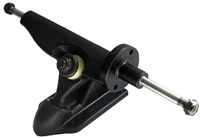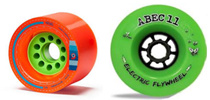This is a work in progress, got some things to add? Let it know!
A beginner guide to DIY an ESK8
So you want to build your own electric skateboard but don’t know where or how to start? No worry this guide will cover the basics of DIY’ing your ESK8. If you want more in-depth guides about some particular subjects, use the search function of the forum. You will find what you’re looking for!
Some more blog posts you can find here.
Very short:
The 3 big components are the motor, the ESC and the battery • The motor gives the mechanical power to your wheels • The ESC (electric speed controller) is the brain of your eks8, it controls the motor using the electric power from the batteries • The batteries give the electric power needed for your motor

Overview
- Motor & motor types a. kV, Watt & dimensions b. Unsensored & sensored motors c. Hub motor
- Mechanical parts for belt drivetrain a. Pulleys & belts b. Mounts c. Wheels
- ESC a. ESC b. VESC®
- Battery a. Voltage, amps, Ah, C-rating b. Serie & parallel, SP c. Charging (balance) & BMS d. Switch & fuse
- Remote
- Enclosure
- Deck
- Interesting articles
1. Motors and motor types
 a. Kv, Watt &dimensions
a. Kv, Watt &dimensions
• Kv or RPM/V or (Rounds per minute)/applied volt is a unit to tell how fast a motor will spin depending on the applied voltage. • Watt [W] is the unit for power, mostly for esk8 motors this will vary between 500W to 3500W per motor. 1HP is 736W, so the strongest motors can go up to almost 5HP (!) • The motors dimensions are given by diameter and length. For example a 6355 motor has 63mmØ and 55mm length.
b. Unsensored & sensored motor
Most motors have just 3 wires, unsensored motors

The sensored motors are a bit more expensive and have a fourth cable the “sensor cable”. This sensor cable detects the position of the rotor. That is why sensored motors are better for smooth startup and helps the ESC to be more efficient.

c. Hub motor
The latest upcoming trend in ESK8 technology are the hub motors, these motors are built in your esk8 wheel.

2. Mechanical parts for belt drivetrain ( a great in depth guide about electric skatboard drivetrains you can find here by @onloop)
a. Pulleys and belts
 Most used is the HTD profile with a pitch of 5mm. You will need a pulley for the motor and a pulley for the wheel and a belt to connect them.
There are different ways to connect the pulleys to the wheel/motor.
Most used is the HTD profile with a pitch of 5mm. You will need a pulley for the motor and a pulley for the wheel and a belt to connect them.
There are different ways to connect the pulleys to the wheel/motor.
The motor pulley is mostly fixed to the motor axle with adjustment screws or a key & keyway. Always check the motor axle diameter and the pulley bore diameter! Most common 6/8/10mm.

The wheel pulley can be fixed to the wheel with screws or kept in place with a bearing and coupler (you will need an adjusted truck).


b. Mounts
Mounts are used to fix the motor to the truck, most used systems are:
Caliber trucks in combination with this clampmount:


Or
Special designed truck for esk8


c. Wheels
Mostly used wheels are flywheel clones, because they cheaper and have holes in the core.

Other common used wheels are the abec flywheels or orangatang kegel wheels.

In fact you can use any wheel if you’re whiling to drill holes in it 
3. ESC
a. ESC
ESC or electric speed controller is the brain from you esk8 and controls the motor. The ESC’s used for esk8’s are mostly RC car ESC’s e.g. Hobbyking X-car 120A, the RC car ESC’s can be used for budget builds. Two important parameters you should check when looking for an ESC are; the number of cells in serie (s) (look further at point 4. Batteries) and the rated Amperage [A]. For example: https://hobbyking.com/en_us/hobbykingr-tm-x-car-beast-series-esc-1-8-scale-120a.html, the hobbyking X-car ESC is rated for 120A and 3-6s (serie cels) LiPo. For your build you will be looking for at least 6s ESC’s & batteries.
b. VESC®
A very famous ESC, that is specially designed for electric vehicles like electric skateboards is the VESC®. The VESC® designed by Benjamin Vedder, an engineer from Sweden. A VESC® allows very smooth startup/braking and silent motors. It also gives the opportunity to change a lot of parameters, like max Amp, voltage cut off, overheat,…
You will find a lot very good in depth guides about the VESC on this formum, just use the search function. A great youtube video you can find here.
Attention: One known Issue that some people have with their VESC compatible ESCs is that when you roll down hill faster than your boards electric top speed, brakes become unpredictable. It might happen that when trying to apply light brakes, The ESC will do a full brake instead.
4. Batteries (A great in depth guide about batteries you can find here by @evoheyax , about C-rating here by @onloop & about terminology and formulae here by @Clonkex )


Li-ion cell LiPo cell
a. Voltage, amps, c-rating, Ah A battery consists of a certain number of cells placed in series or parallel (look below).
Each cell has a voltage window where it should stay in all the time! For LiPo commonly used numbers: 3.2V/cell(completely discharged)-4.2V/cell(completely charged) For Li-Ion commonly used numbers: 2.7V/cell(completely discharged)-4.2V/cell(completely charged) The capacity (how far you will be skating with your battery) is given in Ah or mAh. The number of amperes a battery can give for an hour. For example, a 5Ah batterie can give 5Amps for the time of 1 hour or 20amps for 15 minutes etc… Another commonly used unit for batteries is Wh or (V*A)h or power it can give for one hour. A battery that’s being used will give current, the unit is amperes [A], the max current a battery can deliver is based on the C-rating. A higher c-rating means higher price. Li-ion will be around 5-8C, Lipo’s can go up to 20-40C (!). To know the max continuous discharge current multiply the C-rating by the capacity. For example, a 5Ah(5000mAh) LiPo battery with a 20C rating can give 100amperes(!) continuous discharge.
b. Serie & parallel SP
Battery cells can be placed in series or parallel

The abbreviation for series and parallel is S and P. For example a batter pack that says 8s4p means 8cells in series and 4 in parallel meaning there are 32 cells in the pack. Batteries in esk8’s commonly have 6-12s (cells in serie) and depending on using lipo or lion 1-4p (cells in parallel). The capacity varies between 5Ah to 10Ah.
c. Charging & BMS
When charging a battery it’s very important that all the cells stay at the same voltage and never go higher than 4.2V/cell. To do that you will need a balance charger or a BMS (battery management system). The balance charger needs to know which voltage each cell has to be able to “balance” each cell equally, that’s why the most battery packs have a balance wire (look bellow). The bigger wires are for charging and discharging, they are thicker because they need to conduct more current.

 This is a balance charger, mostly used to charge LiPo’s:
This is a balance charger, mostly used to charge LiPo’s:

A battery management system or BMS is a PCB (printed circuit board) that can be placed in your board with your batteries which allows you to charge your batteries with a laptop like charger without taking them out.

d. Switch and fuse
To protect yourself and your batteries it’s suggested to use a switch or fuse or both.
The cheapest switch is a loop key



5. Remote
Ofcourse you need to control your esk8, that’s why you will need a remote, there are several options. From RC car remotes to Bluetooth app’s to specially designed esk8 remotes.
Hobbyking GT2B Maytech esk8 remote


6. Enclosure
To safely store your electronics under your board you’re egoing to need a case. For this there are several options. You can use a bread box, design and 3D print your enclosure, make it from wood, make it from metal or buy a thermoformed enclosure.

7. Deck (a great in depth guide about decks you can find here by @onloop)
some short general deck info
8. Interesting articles
Are DIY Electric Skateboards Cheaper? | The False Economy by @onloop





 wish I woulda watched that one
wish I woulda watched that one